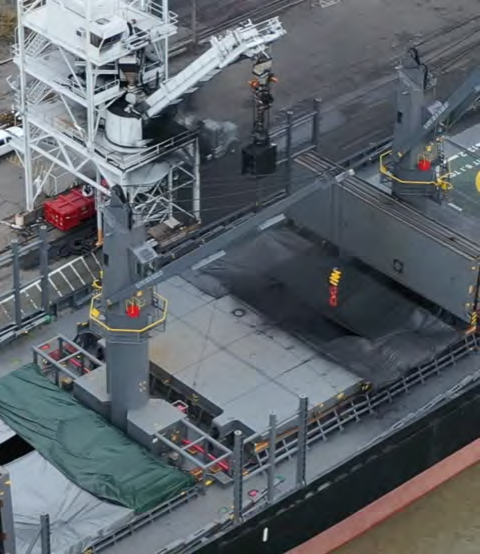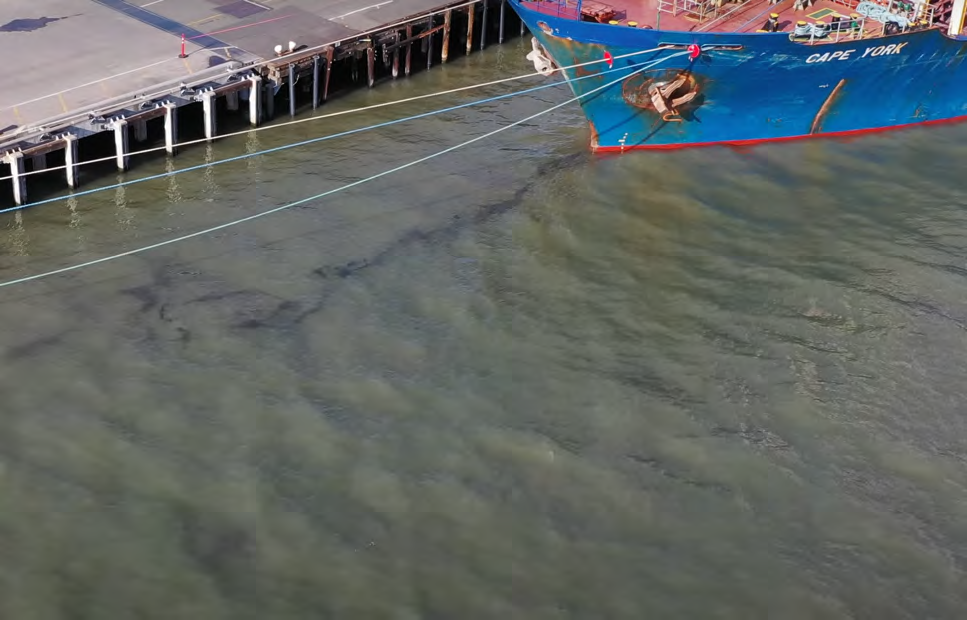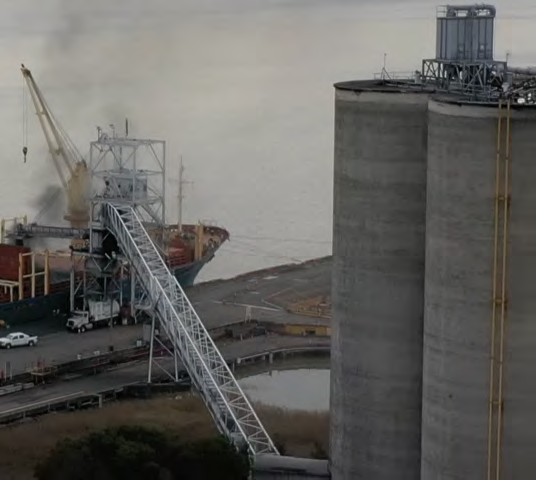
On the Baykeeper article with drone video and photos of petcoke pollution at Port of Benicia

I first heard a report about the petroleum coke plume spreading on the Strait from Benicia’s port on KQED radio yesterday, and now the Vallejo Sun (online news source—see link above)) has run an article that includes a drone video of what appears to be a plume from a coke ship at the Valero dock. Clearly, this can’t be a “first” incident. Thanks to Roger Straw,’s catch, the Benicia Independent ran the story yesterday.
The revelation is no surprise to me, although I’ve never had a drone to capture from the air what I’ve witnessed with my own eyes and photographed from near the port. In 1995, I snapped a picture of a “dust cloud” wafting up into the air from petcoke being dumped into the open hull of a coke ship. That “cloud” had been visible to the naked eye on a misty grey day. I’d reported this to the Air District then, (with photos taken from old camera) and similarly, over the years, to no avail. Petcoke is unregulated by Fed-EPA. (see “why” below).
I also took photos in 2013-2014 of coke trains traveling from the refinery along Bayshore Rd, and I’ve collected petcoke off railroad ties that had sifted out from the hopper cars’ undercarriage (from which hinged flanges open up for dumping coke onto underground conveyor belt at the port, which is then trasferred to the petcoke silos. (see photos below). The coke can still be seen along the tracks–proof of how coke gets airborne from its transport from trains to silos to ships’ hulls.
Petcoke is a dangerous particulate (PM 10 and PM 2.5) that settles on the water and all around the lower Arsenal area in the vicinity of the arts community and Arsenal Historic District. Tiniest invisible particles blow around, becoming part of the carbon grit that settles on cars, window sills, etc. etc.
As most of you know, I’ve railed for years, since 1995, about how petroleum coke is a serious airborne pollutant in our local environment. In 1995, Koch Carbon Industries (subsidiary of Koch Industries) came to Benicia proposing to build a mega-industrial 24/7 petcoke storage and shipping terminal operation that was to serve all five Bay Area refineries including Exxon Benicia (now Valero). That project would have been disastrous for Benicia, creating a massive “toxic coke dump” at our port, with all the cumulative consequences to public health and the environment. We, the public, fought the project fiercely and forced Koch Industries to abandon their proposed “Coke Domes” project. But they went up river and built a smaller coke terminal in Pittsburg instead— speaking of environmental injustice).
If you read no further, the announcement yesterday underscores my point, made over many years and currently, that residential development in the lower Arsenal should not be allowed, because doing so would deliberately create an environmental injustice: the area is inherently industrial and dangerous and polluted by the various specific operations of Valero and Amports. Check it out! Active crude oil pipelines run from the refinery behind our historic Officers’ Row and Clocktower to the Valero tanker dock, (located just east of the Clocktower); petroleum coke is is transferred from the refinery two or three times per week by train along Bayshore Rd to Valero’s petcoke shipping dock (immediately adjacent to Amports’ car import dock); diesel exhaust contributes toxic gases to the air from ships’ engines running while in port and on the Strait. To my knowledge, the cumulative amount of pollution produced everyday in the vicinity of the port has not been calculated.
ABOUT PETCOKE

For those of you not sure about how petcoke is produced and why it’s dangerous to human health: Petroleum coke is the name given to the residue left in the hydrocracker processing unit during the refining of crude oil’s distillates. This residue is an oily, black crumbly carbon substance that must be scraped out of the hydrocracker everyday, and transfered to a “coker” for more processing. to create what’s called “petcoke”. The heavier (dirtier) crude oil refined, the more coke residue is created. The coker unit at Valero transforms the coal-like rocks into a fluffed up powdery-fine granular particulate which is marketed as a product, sold mainly to Asia as a cheap fuel for use in place of more expensive coal in steel furnaces and for other domestic uses. With few exceptions, petcoke cannot be used as a fuel in the US.
Burning petcoke as a fuel contributes to global warming, every bit as much as burning coal or any other fossil fuel. It is also hugely dangerous to human health when inhaled. The coke particulates contain heavy metals, depending on the source of crude oil being refined on any given day. Nickel is a carcinogen when inhaled. PM2.5 particulates of petcoke lodge in the lungs and send other toxic gas molecules—which have piggy-backed onto airborne petcoke particulates—into the bloodstream, thus cumulatively affecting circulatory, heart and lung functions from chronic, daily, low-level exposures breathing airborne petcoke. Of course, petcoke ending up in the water on a regular basis can be ingested by fish and waterfowl and other organisms, contaminating the Strait. Much more investigation of this issue is urgently needed!

The sad, unethical fact is that long ago the oil industry lobbied Fed-EPA to exempt petcoke from regulation as a toxic waste, arguing that petcoke becomes a marketable “finished product” when further processed, and therefore belongs in the same category that includes gasoline, kerosene, diesel, and all other liquid distillates produced by refineries. As more and more heavy crude is being refined in California, our refineries will be producing much more petcoke for export as fuel for burning….
To date, the Bay Area Air Quality Management District (BAAQMD) responds to residents’ complaints about petcoke only if it is visible as an opaque dust cloud when backlit in the air! (This was told to me by BAAQMD staff member).
I hope this helps everyone understand why petcoke is a human health and environmental danger, and why we should NOT be allowing residential development in the lower Arsenal Historic District, for all the enviro reasons cited above. Period!
Please share with your friends!
On the side of public health and safety, social and environmental justice,
Yours truly,
???? Marilyn


























You must be logged in to post a comment.